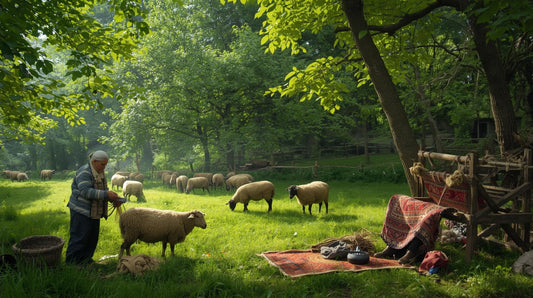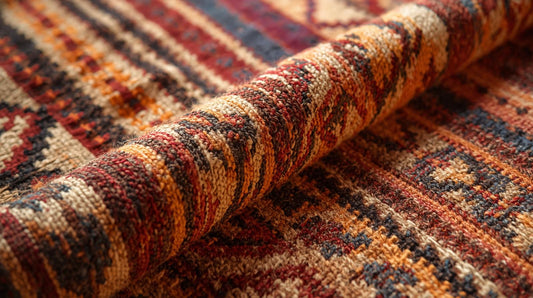From Fleece to Finery: The Journey of a Handwoven Turkish Rug

In a sunlit Anatolian courtyard, a vibrant rug unfurls on a wooden floor, its reds and blues glowing like painted stories. Each knot in this carpet whispers of a journey that began far from this town among grazing sheep, in dye-filled cauldrons, and at an old loom under open sky. The crafting of a Turkish handwoven rug is a living tradition. Over months or even years, artisans transform raw fleece into art, infusing every inch with history and meaning. In the paragraphs that follow, we step into this timeless tapestry of labor and lore, tracing the rug’s path from mountain pasture to finished masterpiece.
-
Shearing and spinning: Villagers shear local sheep or harvest cotton, then wash and hand-spin the fibers into yarn.
-
Dyeing: Yarn is boiled in huge pots of natural dyes — from madder roots (red) and indigo leaves (blue) to onion skins and walnut husks (yellows and browns).
-
Warping the loom: Strong cotton threads are stretched taut on a wooden loom to form the warp, the rug’s foundation, and the design is sketched or marked out.
-
Weaving: In rhythm, the weaver ties wool knots around the warp, knot-by-knot, row by row, building up the pile and pattern.
-
Finishing: When done, the carpet is cut from the loom, beaten, washed in clean water, and sun-dried. The pile is sheared even, edges are secured with fringes, and the colors set.
Gathering the Yarn: Wool and Cotton
Before dawn, the shepherds bring in the sheep. Their heavy coats of fleece will become the rug’s soul. Sheep’s wool is the most common material for a Turkish rug’s pile – prized for its softness, durability, and natural resilience to dirt and temperature. The wool is hand-cleaned and carded, then spun into yarn. “Traditionally, artisans spun wool by hand,” notes a rug guide, turning fleece on simple wheels or spindles until it forms strong, twisted threads. Cotton is less common but essential: it’s used for the loom’s warp and weft threads because cotton is stronger and makes the rug lie flat. In many Anatolian weavings, you’ll find a “wool-on-cotton” construction – soft wool pile woven over a sturdy cotton grid. By midday, baskets overflow with skeins of raw yarn, some left undyed in natural grays or browns, others ready for the next step.
Dyeing in the Sun: Nature’s Palette
Under a canopy or over an open hearth, the workshop fills with the scent of herbs and earth. The yarn is sorted by intended color, then dipped into dye pots. Centuries-old formulas bubble below: deep crimsons from madder roots, indigo blues from plant leaves, golden yellows from onion skins or chamomile, rich browns from oak galls and walnut hulls. A weaver stirs the steaming bath, watching the pale wool slowly draw in color. Time is measured by hue – the longer the yarn steeps, the deeper the tone. When the threads have absorbed the dye, they are lifted out and hung on lines or branches to dry in the sunlight. The bright Anatolian sun helps set the dyes, and the wet yarns drip back into earthy puddles. This natural process means that with age the colors mellow beautifully rather than fade – a prized feature of authentic Turkish rugs.
Spinning and Setting the Loom
With yarn in hand, the weaver and her family turn to the loom. Early evening light filters through the loom’s cloth-wrapped frame as cotton warp threads are stretched tight across it. These vertical threads form the skeleton of the rug. While the warp is set, the wool yarn is pulled into balls and plied: two or more strands are twisted together to add strength, a technique done by hand since ancient times. Each color is arranged in a neat pile beside the loom. Finally, the basic pattern is chalked onto the loom or remembered from a drawn design. In villages, these patterns – geometric medallions, vine scrolls, or symbolic motifs – are often part of the cultural heritage, passed down stitch by stitch. The loom stands ready.
Knot by Knot: Weaving the Carpet
Now the real magic begins. The weaver sits at the loom, back straight, legs braced. She ties knots with rhythmic precision. Using the Turkish double knot, each tuft of wool is looped around a pair of warp threads. After pulling each knot tight, she threads one or two horizontal wefts of cotton or wool across, securing the row. She then takes a wooden comb-like tool – a kirkit – and pushes the knots firmly down against the finished work. With each pass, the colorful design emerges like a painting: a band of red here, a diamond of turquoise there. The combing makes the pile even, “pushing the knots down… [to] make them stronger,” as one rug blog notes. The room grows quiet except for the clack of knots and the swipe of the comb. Over days and weeks, the rug grows inch by inch, its pattern unfolding under skilled hands.
Patterns in Thread: Motifs and Stories
Every woven Turkish rug is a tapestry of symbols. The motifs reflect village life, beliefs, and personal stories. For example, a stylized Elibelinde (hand-on-hip figure) motif often graces the field, symbolizing pregnancy, motherhood, and abundance. Paired ram’s horns (Koçboynuzu) in the corners stand for courage and masculinity. Other symbols have very personal meanings: a saçbağı (hair-tie) motif might quietly declare a young woman’s readiness for marriage, and a tulip motif can express her hope for a child. In the borders, charms appear too – a woven evil eye (nazar) or triangular muska is meant to ward off misfortune, and a wolf’s paw edge knot can protect the shepherd’s flocks. In this way, each rug becomes an heirloom diary: talismans of protection, prayers for family, and wishes for prosperity are all knotted into the wool.
Woven in Heritage: History and Significance
The craft of rug-weaving is woven deep into Turkey’s history. Nomadic Turkic tribes brought their tapestry techniques into Anatolia in the 11th century under the Seljuks, and rug-making flourished under the Ottomans. By the 15th century, Ottoman sultans were gifting Turkish carpets to European nobility, and artists painted these rich textiles into Renaissance interiors. Even a 2500-year-old Pazırık carpet was found in a Scythian burial mound – testament to a tradition that stretches back to antiquity.. In Turkish homes and mosques, handmade rugs have long been treasured for their beauty and utility, marking status and hospitality. Today, each hand-knotted rug still carries the soul of Anatolia: a fusion of art, folklore, and community that makes it much more than a floor covering.
Finishing Touches: Washing and Fringing
When the last knot is tied, the work is nearly done. The weaver cuts the loops of the pile with sharp scissors to a uniform height. She ties and wraps the rug’s ends to form hand-knotted fringes, sealing the edges. Next comes the al fresco bath: the rug is laid flat and bathed in water to remove oils, dirt, and excess dye. Sometimes wooden beaters or sturdy scrubbing brushes are used to work the water through the wool. After rinsing, the wet rug is stretched out under the sun. “The weaving process is often followed by thorough washing and sun drying,” notes one weaver’s journal. In the heat, the fibers relax and the colors brighten. Finally, the pile is combed one more time – trimmed and even – so the surface is silky and soft to the hand.
In the golden afternoon light, the finished rug is rolled out for all to see. Threads that began as flock on distant hillsides now form an intricate saga on the floor. Each fiber has journeyed through fire and water, through stories and symbols. The result is a warm new hearth for a home, and a living piece of Turkish heritage that will be cherished for generations.
No comments







0 comments